8.1 Emotional Experience: The Feeling Machine

Leonardo doesn’t know what love feels like and there’s no way to teach him, because trying to describe the feeling of love to someone who has never experienced it is a bit like trying to describe the color green to someone who was born blind. We could tell Leonardo what causes the feeling (“It happens whenever I see Marilynn”) and we could tell him about its consequences (“I breathe hard and say goofy stuff”), but in the end these descriptions would miss the point because the essential feature of love–like the essential feature of all emotions–is the experience. It feels like something to love, and what it feels like is love’s defining attribute (Heavey, Hurlburt, & Lefforge, 2012).
What Is Emotion?
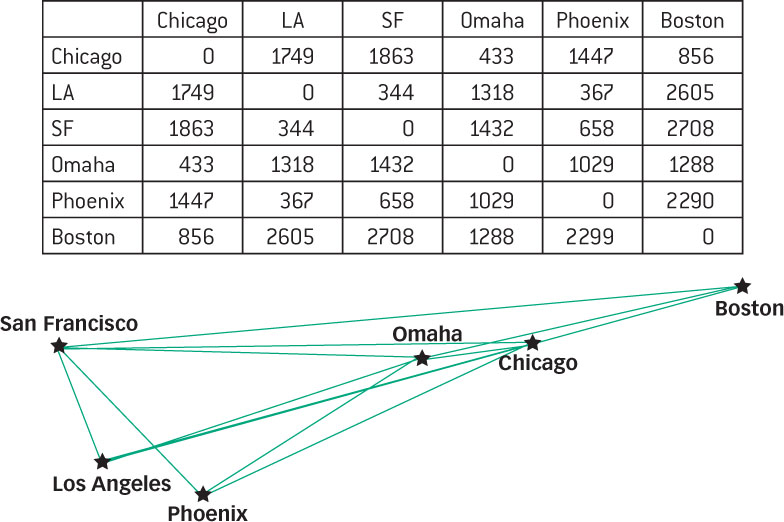
 Figure 8.1: From Distances to Maps Knowing the distances between things–like cities, for example–allows us to draw a map that reveals the dimensions on which they vary.
Figure 8.1: From Distances to Maps Knowing the distances between things–like cities, for example–allows us to draw a map that reveals the dimensions on which they vary.
How can we study something whose defining attribute defies description? Psychologists have developed a clever technique that capitalizes on the fact that although people can’t always say what an emotional experience feels like (“Love is … um … uh…”), they usually can say how similar one experience is to another (“Love is more like happiness than like anger”). By asking people to rate the similarity of dozens of emotional experiences, psychologists have been able to use a technique known as multidimensional scaling to create a map of those experiences. The mathematics behind this technique is complex, but the logic is simple. If you drew up a list of the distances between a half-
315
The same technique can be used to generate a map of the emotional landscape. If you listed the similarity of a large number of emotional experiences (assigning smaller distances to those that feel similar and larger distances to those that feel dissimilar) and then challenged a friend to incorporate them into a map, your friend would be forced to draw a map like the one shown in FIGURE 8.2. This is the unique map that allows every emotional experience to be precisely the right distance from every other. What good is this map? As it turns out, maps don’t just show how close things are to each other: They also reveal the dimensions on which those things vary. For example, the map in Figure 8.2 reveals that emotional experiences differ on two dimensions called valence (how positive or negative the experience is) and arousal (how active or passive the experience is). Research shows that all emotional experiences can be described by their unique coordinates on this two-
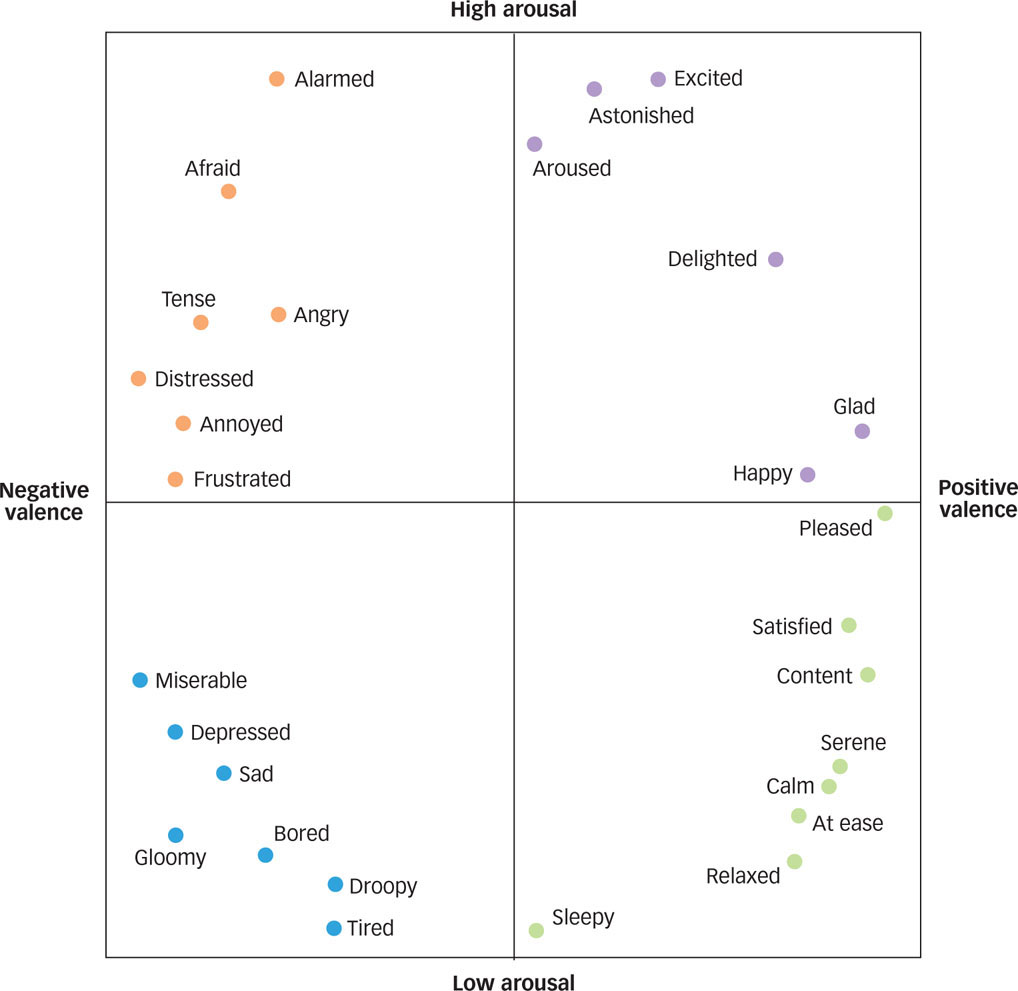
 Figure 8.2: Two Dimensions of Emotion Just as cities can be mapped by their longitude and latitude, emotions can be mapped by their arousal and valence.
Figure 8.2: Two Dimensions of Emotion Just as cities can be mapped by their longitude and latitude, emotions can be mapped by their arousal and valence.
Why do psychologists use multidimensional scaling?
316
This map of emotional experience suggests that any definition of emotion must include two things: first, the fact that emotional experiences are good or bad; and second, the fact that these experiences are have characteristic levels of bodily arousal. With these two facts in mind, we can define emotion as a positive or negative experience that is associated with a particular pattern of physiological activity. As you are about to see, the first step in understanding emotion involves understanding how the experience part and the physiological activity part of this definition are related.
The Emotional Body
You probably think that if you walked into your kitchen right now and saw a bear nosing through the cupboards, you would feel fear, your heart would start to pound, and the muscles in your legs would prepare you for running. But in the late 19th century, William James suggested that the events that produce an emotion might actually happen in the opposite order: First you see the bear, then your heart starts pounding and your leg muscles contract, and then you experience fear, which is nothing more than your experience of your body’s response. As James (1884, pp. 189–190) wrote, “Bodily changes follow directly the perception of the exciting fact…. And feeling of the same changes as they occur is the emotion.” For James, each unique emotional experience was the result of a unique pattern of physiological responses, and he suggested that without all the heart pounding and muscle clenching, there would be no experience of emotion at all. Psychologist Carl Lange suggested something similar at about the same time, so the idea, now known as the James-Lange theory> of emotion, is that a stimulus triggers activity in the body, which in turn produces an emotional experience in the brain. According to this theory, emotional experience is the consequence–not the cause–of our physiological reactions to objects and events in the world.

James’s former student, Walter Cannon, didn’t like this idea very much, and so together with his student, Philip Bard, he proposed an alternative. The Cannon-Bard theory> of emotion is the theory that a stimulus simultaneously triggers activity in the body and emotional experience in the brain (Bard, 1934; Cannon, 1927). Cannon claimed that his theory was better than the James–Lange theory for several reasons. First, he noted, emotions happen quickly even though the body often reacts slowly. For example, a blush is a bodily response to embarrassment that takes 15 to 30 seconds to occur, and yet, people feel embarrassed within seconds of noticing that, oh say, their pants have fallen off in public. So how could the blush be the cause of the feeling? Second, people often have difficulty accurately detecting bodily responses, such as changes in their heart rates. If people cannot detect changes in their heart rates, then how can they experience those changes as an emotion? Third, nonemotional stimuli–such as an increase in room temperature–can cause the same bodily response as emotional stimuli do. So why don’t people feel afraid when they get a fever? Finally, Cannon noted that there simply weren’t enough unique patterns of bodily activity to account for all the unique emotional experiences people have. If many different emotional experiences are associated with the same pattern of bodily activity, then how could that pattern of activity be the sole determinant of the emotional experience?
These are all good questions, and about 30 years after Cannon asked them, psychologists Stanley Schachter and Jerome Singer supplied some answers (Schachter & Singer, 1962). James and Lange were right, they claimed, to equate emotion with the perception of one’s bodily reactions. But Cannon and Bard were right, they claimed, to note that there are not nearly enough distinct bodily reactions to account for the wide variety of emotions that human beings can experience. Whereas James and Lange had suggested that different emotions are different experiences of different patterns of bodily activity, Schachter and Singer claimed that different emotions are merely different interpretations of a single pattern of bodily activity, which they called “undifferentiated physiological arousal” (see FIGURE 8.3).
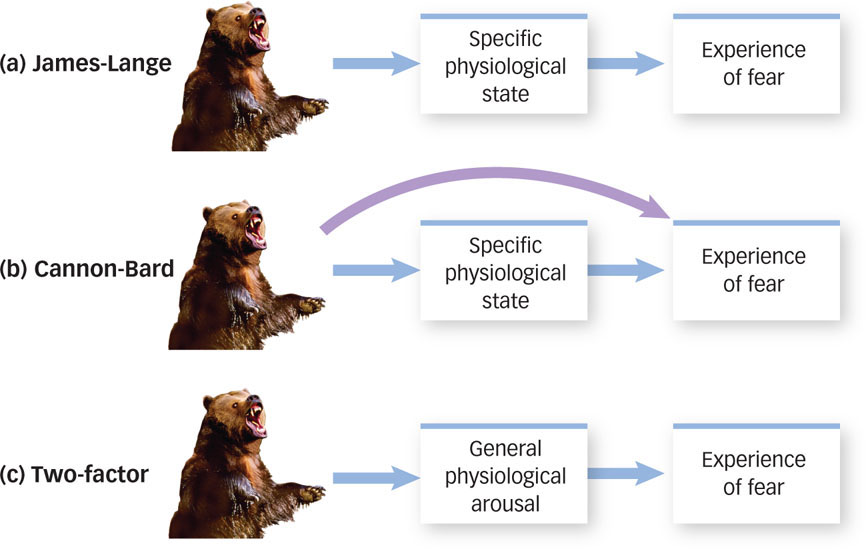
 Figure 8.3: Classic Theories of Emotion Classic theories make different claims about the origins of emotion. The James-
Figure 8.3: Classic Theories of Emotion Classic theories make different claims about the origins of emotion. The James-317
How did the two-
Schachter and Singer’s two-factor theory of emotion is the theory that emotions are based on inferences about the causes of physiological arousal. When you see a bear in your kitchen, your heart begins to pound. Your brain quickly scans the environment, looking for a reasonable explanation for all that pounding, and notices, of all things, a bear. Having noticed both a bear and a pounding heart, your brain then does what brains do so well: It puts two and two together, makes a logical inference, and interprets your arousal as fear. In other words, when you are physiologically aroused in the presence of something that you think should scare you, you label that arousal as fear. But if you have precisely the same bodily response in the presence of something that you think should delight you, then you might label that arousal as excitement. According to Schachter and Singer, people have the same physiological reaction to all emotional stimuli, but they interpret that reaction differently on different occasions.

How has the two-
318
However, research has not been so kind to the model’s claim that all emotional experiences are merely different interpretations of the same bodily state. For example, researchers measured participants’ physiological reactions as they experienced six different emotions and found that anger, fear, and sadness each produced a higher heart rate than disgust; that fear and disgust produced higher galvanic skin response (sweating) than did sadness or anger; and that anger produced a larger increase in finger temperature than did fear (Ekman, Levenson, & Friesen, 1983; see FIGURE 8.4). These findings have been replicated across different age groups, professions, genders, and cultures (Levenson, Ekman, & Friesen, 1990; Levenson et al., 1991, 1992). In fact, some physiological responses seem unique to a single emotion. For example, a blush is the result of increased blood volume in the subcutaneous capillaries in the face, neck, and chest, and research suggests that people blush when they feel embarrassment but not when they feel any other emotion (Leary et al., 1992). Similarly, certain patterns of activity in the parasympathetic branch of the autonomic nervous system (which is responsible for slowing and calming rather than speeding and exciting) seem uniquely related to prosocial emotions such as compassion (Oately, Keltner, & Jenkins, 2006).
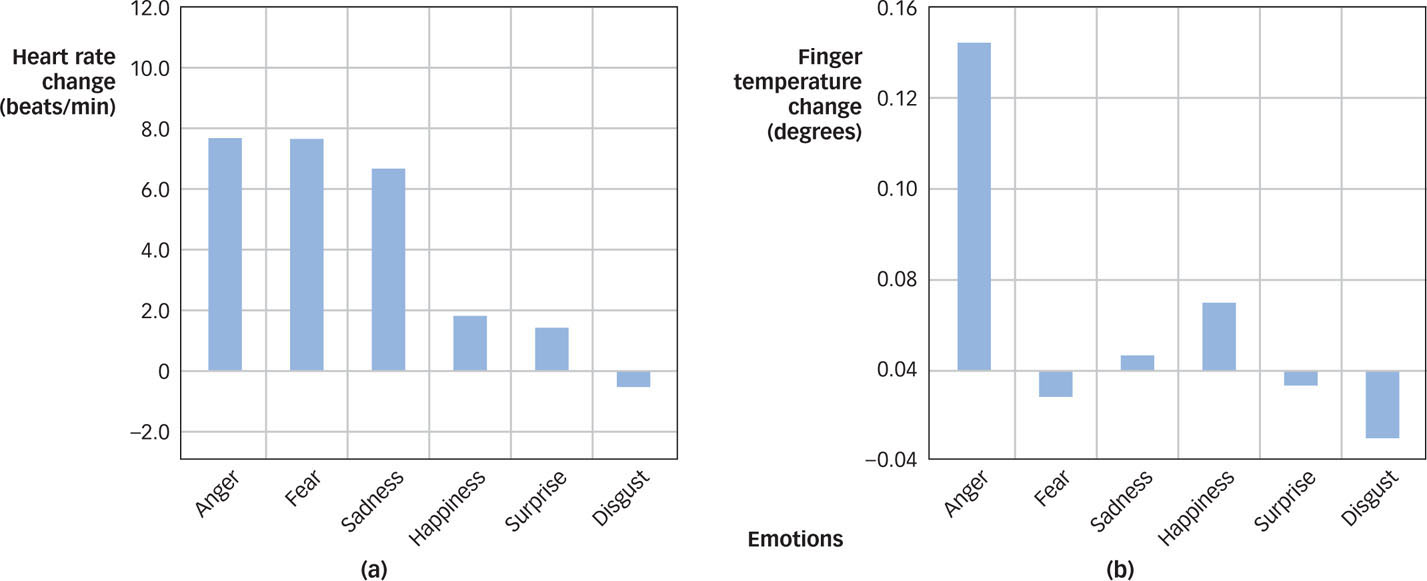
 Figure 8.4: The Physiology of Emotion Contrary to the claims of the two-
Figure 8.4: The Physiology of Emotion Contrary to the claims of the two-So which of these duos was right? James and Lange were right when they suggested that patterns of physiological response are not the same for all emotions. But Cannon and Bard were right when they suggested that people are not perfectly sensitive to these patterns of response, which is why people must sometimes make inferences about what they are feeling. Our bodily activity and our mental activity are both the causes and the consequences of our emotional experience. The precise nature of their interplay is not yet fully understood, but as you are about to see, much progress has been made over last few decades by following the trail of emotion from the beating heart to the living brain.
319
The Emotional Brain

In the late 1930s, psychologist Heinrich Klüver and physician Paul Bucy made an accidental discovery. A few days after performing brain surgery on a monkey named Aurora, they noticed that she was acting strangely. First, Aurora would eat just about anything and have sex with just about anyone–as though she could no longer distinguish between good and bad food, or between good and bad mates. Second, Aurora seemed absolutely fearless and unflappable, remaining calm when she was handled by experimenters, and even when she was confronted by snakes (Klüver & Bucy, 1937, 1939). What had happened to her? As it turned out, during the surgery, Klüver and Bucy had accidentally damaged a structure in Aurora’s brain called the amygdala. Subsequent studies confirmed that the amygdala plays a special role in producing emotions such as fear. For example, in one study, researchers performed an operation so that information entering a monkey’s left eye was transmitted to its amygdala, but information entering the monkey’s right eye was not (Downer, 1961). When the monkey was allowed to see a threatening stimulus with only its left eye, it responded with fear and alarm, but when it was allowed to see the threatening stimulus with only its right eye, it was calm and unruffled. Research with humans shows much the same thing. For example, people normally have superior memory for emotionally evocative words such as death or vomit, but people whose amygdalae are damaged (LaBar & Phelps, 1998) or who take drugs that temporarily impair neurotransmission in the amygdala (van Stegeren et al., 1998) do not (see FIGURE 8.5). Interestingly, although people with amygdala damage often don’t feel fear when they see a threat, they do feel fear when they experience a threat, for example, when they suddenly find they can’t breathe (Feinstein et al., 2013).
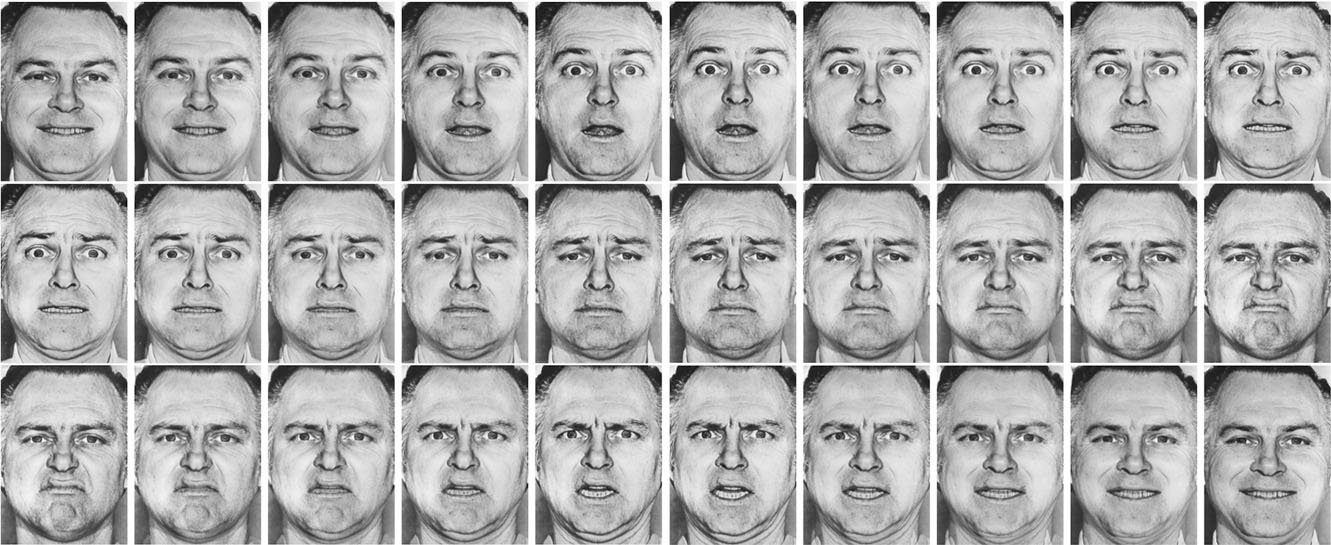
 Figure 8.5: Emotion Recognition and the Amygdala Facial expressions of emotion were morphed into a continuum that ran from happiness to surprise to fear to sadness to disgust to anger and back to happiness. This sequence was shown to a patient with bilateral amygdala damage and to a control group of 10 people without brain damage. Although the patient’s recognition of happiness, sadness, and surprise was generally in line with that of the control group, her recognition of anger, disgust, and fear was impaired (Calder et al., 1996).
Figure 8.5: Emotion Recognition and the Amygdala Facial expressions of emotion were morphed into a continuum that ran from happiness to surprise to fear to sadness to disgust to anger and back to happiness. This sequence was shown to a patient with bilateral amygdala damage and to a control group of 10 people without brain damage. Although the patient’s recognition of happiness, sadness, and surprise was generally in line with that of the control group, her recognition of anger, disgust, and fear was impaired (Calder et al., 1996).
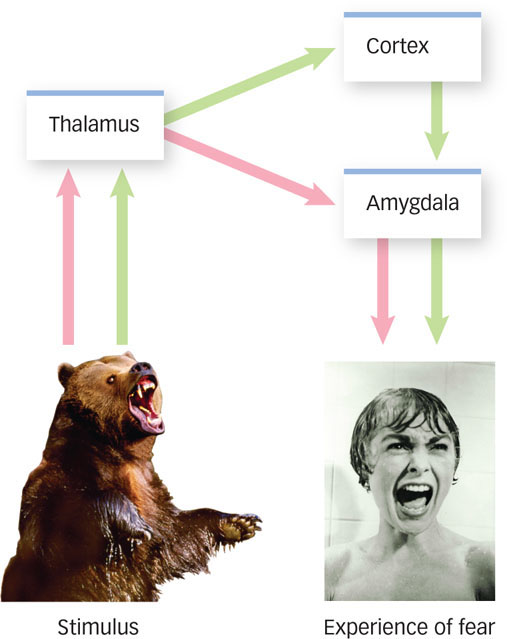
 Figure 8.6: The Fast and Slow Pathways of Fear A ccording to Joseph LeDoux (2000), information about a stimulus takes two routes simultaneously: the “fast pathway” (shown in pink), which goes from the thalamus directly to the amygdala, and the “slow pathway” (shown in green), which goes from the thalamus to the cortex and then to the amygdala. Because the amygdala receives information from the thalamus before it receives information from the cortex, people can be afraid of something before they know what it is.
Figure 8.6: The Fast and Slow Pathways of Fear A ccording to Joseph LeDoux (2000), information about a stimulus takes two routes simultaneously: the “fast pathway” (shown in pink), which goes from the thalamus directly to the amygdala, and the “slow pathway” (shown in green), which goes from the thalamus to the cortex and then to the amygdala. Because the amygdala receives information from the thalamus before it receives information from the cortex, people can be afraid of something before they know what it is.
PARAMOUNT PICTURES/THE KOBAL COLLECTION
What exactly does the amygdala do? Is it some sort of “fear center”? Not exactly (Cunningham & Brosch, 2012). Before an animal can feel fear, its brain must first decide that there is something to be afraid of. This decision is called an appraisal, which is an evaluation of the emotion-
320
The cortex takes much longer to process this information, but when it finally does, it sends a signal to the amygdala. That signal can tell the amygdala to maintain the state of fear (“We’ve now analyzed all the data up here, and sure enough, that thing is a bear–and bears bite!”) or decrease it (“Relax, it’s just some guy in a bear costume”). When experimental subjects are instructed to experience emotions such as sadness, fear, and anger, they show increased activity in the amygdala and decreased activity in the cortex (Damasio et al., 2000), but when they are asked to inhibit these emotions, they show increased cortical activity and decreased amygdala activity (Ochsner et al., 2002). In a sense, the amygdala presses the emotional gas pedal and the cortex then hits the brakes. That’s why both adults with cortical damage and children (whose cortices are not well developed) have difficulty inhibiting their emotions (Stuss & Benson, 1986).
How do the limbic system and cortex interact to produce emotion?
Studies of the brain suggest that emotion is part of a primitive system that prepares us to react rapidly and on the basis of little information to things that are relevant to our survival and well-
The Regulation of Emotion
You may or may not care about hedgehogs, earwax, or the War of 1812, but if you are human, you almost certainly care about what you are feeling. Emotion regulation refers to the strategies people use to influence their own emotional experience, and although people occasionally want to experience negative emotions rather than positive emotions (Erber, Wegner, & Therriault, 1996; Michaela et al., 2009; Parrott, 1993; Tamir & Ford, 2012), most of the time people would rather feel good than bad.
Nine out of 10 people report that they attempt to regulate their emotional experience at least once a day (Gross, 1998), and they describe more than a thousand different strategies for doing so (Parkinson & Totterdell, 1999). Some of these are behavioral strategies (e.g., avoiding situations that trigger unwanted emotions) and some are cognitive strategies (e.g., recruiting memories that trigger the desired emotion; Webb, Miles, & Sheeran, 2012). Research shows that people don’t always know which strategies will be most effective. For example, people tend to think that suppression, which involves inhibiting the outward signs of an emotion, is an effective strategy. But by and large, it isn’t (Gross, 2002). Conversely, people tend to think that affect labeling, which involves putting one’s feelings into words, will have little impact on their emotions, when in fact, it is generally effective in reducing the intensity of emotional states (Lieberman et al., 2011).
How, and how well, does reappraisal work?

One of the best strategies for emotion regulation is reappraisal, which involves changing one’s emotional experience by changing the way one thinks about the emotion-
321
Reappraisal is an important skill. Some people are better at it than others (Malooly, Genet, & Siemer, 2013), and the ability to reappraise is associated with both mental and physical health (Davidson, Putnam, & Larson, 2000; Gross & Munoz, 1995). Indeed, as you will learn in the Stress and Health chapter, therapists often attempt to alleviate depression and distress by teaching people how to reappraise key events in their lives (Jamieson, Mendes, & Nock, 2013). On the other hand, this ability can allow us to be less compassionate toward those who are suffering (Cameron & Payne, 2011). About two thousand years ago, Roman emperor Marcus Aurelius wrote: “If you are distressed by anything external, the pain is not due to the thing itself, but to your estimate of it; and this you have the power to revoke at any moment.” Modern science suggests that the emperor was on to something.
 Emotional experiences are difficult to describe, but psychologists have identified their two underlying dimensions: arousal and valence.
Emotional experiences are difficult to describe, but psychologists have identified their two underlying dimensions: arousal and valence. Psychologists have spent more than a century trying to understand how emotional experience and physiological activity are related. The James-
Psychologists have spent more than a century trying to understand how emotional experience and physiological activity are related. The James-Lange theory suggests that a stimulus causes a physiological reaction, which leads to an emotional experience; the Cannon–Bard theory suggests that a stimulus causes both an emotional experience and a physiological reaction simultaneously; and Schachter and Singer’s two- factor theory suggests that a stimulus causes undifferentiated physiological arousal about which people draw inferences. None of these theories are entirely right, but each has elements that are supported by research.  Emotions are produced by the complex interaction of limbic and cortical structures. Information about a stimulus is sent simultaneously to the amygdala (which makes a quick appraisal of the stimulus’s goodness or badness) and the cortex (which does a slower and more comprehensive analysis of the stimulus). In some instances, the amygdala will trigger an emotional experience that the cortex later inhibits.
Emotions are produced by the complex interaction of limbic and cortical structures. Information about a stimulus is sent simultaneously to the amygdala (which makes a quick appraisal of the stimulus’s goodness or badness) and the cortex (which does a slower and more comprehensive analysis of the stimulus). In some instances, the amygdala will trigger an emotional experience that the cortex later inhibits. People care about their emotional experiences and use many strategies to regulate them. Reappraisal involves changing the way one thinks about an object or event, and is one of the most effective strategies for emotion regulation.
People care about their emotional experiences and use many strategies to regulate them. Reappraisal involves changing the way one thinks about an object or event, and is one of the most effective strategies for emotion regulation.
322